The Arch of Titus (Italian: Arco di Tito; Latin: Arcus Titi) is an enduring symbol of the Roman Empire’s architectural and military prowess. Constructed to commemorate Emperor Titus’s victory in Judea and the conquest of Jerusalem, the arch stands as a testament to Roman artistry and historical significance. Below, we delve into its history, design, and the powerful stories it tells through its intricate reliefs. Follow archeology.dulichvn.net to discover many hidden mysteries that have yet to be discovered.
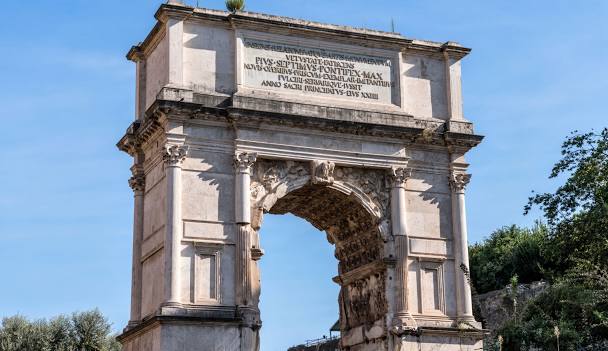
History and Purpose of the Arch of Titus
The Arch of Titus was erected in 81 CE by Emperor Domitian, shortly after the death of his older brother, Emperor Titus. Its primary purpose was to honor Titus’s triumph in the Jewish War, particularly the monumental conquest of Jerusalem in 70 CE.
1. Celebrating the Conquest of Jerusalem
The Arch of Titus stands as a monumental commemoration of one of the Roman Empire’s most pivotal military victories—the conquest of Jerusalem in 70 CE. This campaign culminated in the destruction of the Second Temple, a sacred structure central to Jewish faith and culture. The event not only symbolized the crushing of a significant uprising in Judea but also marked the definitive assertion of Roman authority in the region. For the Romans, this victory was not merely a military triumph but a moment of profound political and cultural dominance. By commemorating this conquest, the arch reinforced Rome’s image as an invincible power and a bastion of imperial control.
The depiction of sacred artifacts, such as the Menorah and other treasures looted from the Temple, immortalizes the spoils of war while reminding onlookers of the grandeur of the Roman Empire. This visual narrative not only glorified Emperor Titus’s leadership but also served as a propagandistic tool to instill awe and reverence among Roman citizens and visitors alike.
2. A Tribute to Emperor Titus
Constructed by Emperor Domitian in 81 CE, the Arch of Titus was more than a monument to Rome’s military success—it was a deeply personal tribute to the legacy of his elder brother, Emperor Titus. By commissioning the arch shortly after Titus’s death, Domitian sought to immortalize his brother’s achievements and ensure that his memory remained etched in Roman history.
The arch portrays Titus not just as a victorious leader but also as a divine figure, crowned in a chariot and surrounded by celestial imagery. This was a deliberate choice, intended to elevate his status to that of a god-like hero. In Roman culture, triumphal arches were a way to blend historical commemoration with divine veneration, and the Arch of Titus achieves this seamlessly. It stood as a reminder to the Roman people of Titus’s unparalleled accomplishments, while also consolidating Domitian’s own position as a ruler who respected and honored the imperial lineage.
3. Historical and Architectural Significance
The Arch of Titus holds the distinction of being the oldest surviving triumphal arch in Rome, making it a cornerstone in the study of Roman architecture and historical symbolism. Its design and construction set the standard for later triumphal arches, influencing some of the most iconic structures in world history, such as the Arc de Triomphe in Paris and the Brandenburg Gate in Berlin.
Beyond its architectural legacy, the Arch of Titus serves as a vital historical artifact. It offers a window into the cultural, political, and military priorities of ancient Rome. The detailed reliefs, inscriptions, and overall structure of the arch encapsulate the essence of Roman propaganda—celebrating victories, deifying leaders, and projecting imperial power.
Moreover, the arch’s location on the Via Sacra, the main ceremonial road of the Roman Forum, underscores its significance. Positioned at a key crossroads of Roman civic life, the arch would have been a focal point during triumphal processions, ensuring that its message of victory and dominance resonated with all who passed beneath it. Today, it stands as a tangible link to Rome’s storied past, a symbol of an empire that once ruled much of the known world.
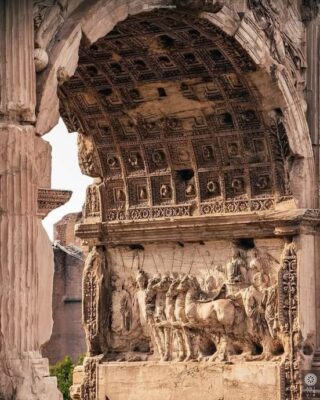
Architectural Design of the Arch
The Arch of Titus is a single-passage structure, towering at 15.4 meters in height. Its design is a fine example of Roman engineering and artistic sophistication.
1. Dimensions and Architectural Structure
While the Arch of Titus may seem modest in scale compared to grander triumphal arches built in later centuries, its architectural brilliance lies in its harmonious proportions and refined detailing. Rising to a height of 15.4 meters, the arch features a single-passageway design, emphasizing simplicity and elegance. The clean lines of the structure, combined with its balanced proportions, create a visually striking monument that commands attention without overwhelming its surroundings.
The materials used, predominantly white marble, add to the arch’s dignified appearance, reflecting sunlight to enhance its visibility and grandeur. Every element of its structure—from the Corinthian capitals crowning the columns to the carefully inscribed dedicatory text—is a testament to the meticulous craftsmanship of Roman builders. The Arch of Titus is not merely a functional gateway; it is a meticulously designed masterpiece that bridges utility with aesthetic excellence.
2. Sculptural Relief Decorations
The Arch of Titus is richly adorned with sophisticated relief sculptures that transform it from a mere architectural structure into a vivid narrative of Roman history and triumph. These reliefs are more than decorative elements—they are visual stories carved in stone, capturing key moments of Emperor Titus’s victorious campaign in Judea.
On one side, the relief depicts Titus in a triumphal chariot, crowned with a laurel wreath, a symbol of victory and divine favor. Surrounding him are allegorical figures, including the goddess Victory and personifications of virtues, reinforcing his status as a heroic and almost divine ruler. On the opposite panel, a poignant scene unfolds: Roman soldiers carrying the sacred treasures of the Jewish Temple in Jerusalem, such as the Menorah, trumpets, and ceremonial table. The intricate details of these carvings bring to life the spoils of war and the magnitude of Rome’s triumph.
These reliefs are a masterclass in Roman artistic ingenuity, blending realism in their depiction of human figures and objects with symbolism that conveys deeper themes of power, divinity, and conquest. They serve as a visual celebration of the empire’s might while subtly immortalizing the cultural and religious significance of the events they depict.
3. Strategic Location on the Via Sacra
The Arch of Titus is strategically positioned on the Via Sacra, the principal ceremonial road that winds through the Roman Forum. This location was not chosen arbitrarily; it placed the arch at the very heart of Roman civic and religious life. As the site of triumphal processions and public celebrations, the Via Sacra was a bustling artery of activity, ensuring that the arch’s message of imperial power reached the widest audience.
Situated near other iconic structures like the Temple of Venus and Roma, the arch functioned as a symbolic gateway, marking a key point along the route of victorious generals returning to the Forum. As they passed beneath the arch during their triumphal march, the procession would pause momentarily, allowing the people to witness and venerate the reliefs celebrating Rome’s dominance.
The choice of this prominent location further elevated the significance of the arch, transforming it into more than a static monument. It became an interactive element of Roman public life, constantly reinforcing the empire’s narrative of power and glory to all who traversed the sacred road. Even today, standing on the Via Sacra and gazing at the Arch of Titus, visitors are transported back in time to experience the grandeur of ancient Rome’s ceremonial heart.
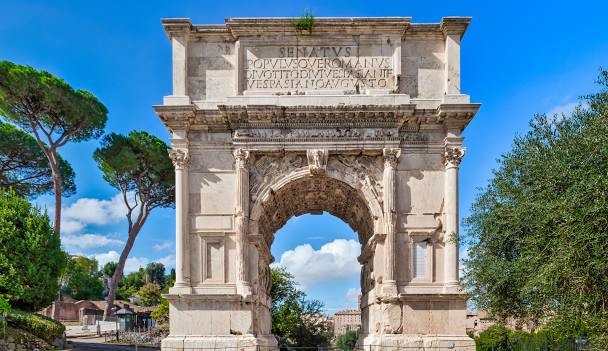
Reliefs and Symbolism
The reliefs inside the Arch of Titus are its most captivating feature, offering a glimpse into Roman triumphal ceremonies and the spoils of war.
1. Emperor Titus in Victory
On one side of the Arch of Titus, a breathtaking relief depicts Emperor Titus in a triumphant chariot, his figure resplendent with a laurel wreath crowning his head—a timeless symbol of victory and divine favor. This imagery elevates Titus to a near-mythical status, reinforcing his role as a powerful and almost god-like figure in Roman society. His posture exudes authority and strength, as he is portrayed as the ultimate victor, riding triumphantly in a grand procession through the streets of Rome. The careful attention to detail in his depiction—his armor, flowing robes, and commanding presence—evokes the grandeur and heroism associated with imperial Rome.
The scene is imbued with symbolism, emphasizing not only military success but also divine endorsement, a reflection of how the Romans linked military conquests to religious sanctity. This relief serves as a visual testament to Titus’s accomplishments, ensuring his place in history as a celebrated leader who guided Rome to triumph through both military and moral authority.
2. Spoils from Jerusalem
On the opposite side of the arch, another profound relief captures the spoils taken from the Jewish Temple in Jerusalem. This striking scene vividly illustrates the immense wealth plundered during the Roman conquest—an act that symbolized the subjugation of Judea and the dominance of Roman power over the region. Among the sacred artifacts depicted are the Menorah, the Trumpets, and other religious vessels, which are carefully carried by Roman soldiers in triumph.
The meticulous detailing of these objects serves to highlight their significance. The Menorah, for instance, stands as a powerful emblem of Jewish heritage, now forced into submission under the weight of Roman imperial dominance. These treasures are not merely trophies of war; they are symbols of cultural dominance, representing the power of Rome’s ability to erase or absorb opposing religious and cultural identities.
This relief is a vivid reminder of Rome’s prowess and its ability to impose its authority over even the most sacred symbols of conquered civilizations. The emotional impact of this scene is enhanced by the expressions of the soldiers and the solemnity of the act, making it a powerful depiction of triumph and conquest.
3. A Symbol of Roman Power
The two opposing reliefs on the Arch of Titus—depicting Titus’s victory and the spoils from Jerusalem—serve as a cohesive narrative of Roman strength and dominance. Together, these carvings immortalize Titus’s remarkable achievements, highlighting his role in expanding and consolidating Roman power.
These depictions go beyond mere historical documentation; they are deeply embedded in Roman ideology, celebrating the empire’s enduring legacy. The arch, through its intricate artistry, acts as a constant reminder of Rome’s military supremacy, emphasizing the Emperor’s leadership as central to the empire’s success.
Furthermore, these reliefs reinforce the idea that Rome’s strength lay not only in its military might but in its ability to assimilate and transform other cultures into Roman dominion. The lasting legacy of the Arch of Titus lies not just in its physical grandeur, but in its ability to preserve and convey Rome’s enduring influence—an enduring testament to the city’s unparalleled power and dominance over history.
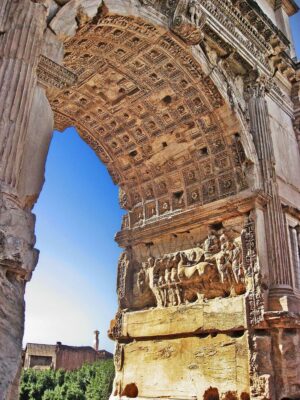
See more: 7500-Year-Old Figurine Neolithic: A Glimpse into Europe’s Prehistoric Fashion
Legacy of the Arch of Titus
The Arch of Titus remains a must-visit landmark in Rome, drawing history enthusiasts and tourists alike. Its influence extends beyond its time, serving as an inspiration for triumphal arches around the world.
1. Preservation Efforts
Over the centuries, the Arch of Titus has weathered the passage of time, enduring wars, natural elements, and human neglect. However, through dedicated restoration efforts, its grandeur and historical significance have been preserved for future generations to experience. These restoration projects have meticulously repaired and maintained the intricate reliefs, ensuring that the vivid narratives of Roman triumph and culture remain accessible. From cleaning to structural reinforcement, each effort has been crucial in safeguarding this ancient monument, allowing it to continue serving as a bridge between the past and present.
The resilience of the Arch of Titus highlights the Romans’ expertise in durable construction and the lasting legacy of their engineering ingenuity. These preservation initiatives reflect the importance of maintaining historical sites as windows into the rich history and achievements of ancient Rome.
2. Impact on Later Architecture
The design of the Arch of Titus has left an indelible mark on the field of architecture, influencing numerous structures throughout history. From the grandeur of the Arc de Triomphe in Paris to modern-day triumphal arches and commemorative monuments, the stylistic elements of the Arch of Titus have become a blueprint for subsequent generations of architects and designers. Its innovative combination of proportion, relief artistry, and symbolic storytelling has set a standard that continues to inspire architects worldwide.
The arch’s structural balance, use of classical motifs, and masterful integration of reliefs showcase the enduring legacy of Roman engineering and artistic expression. It serves as a timeless example of how architecture can merge utility with historical and cultural significance, influencing everything from civic monuments to public spaces in contemporary society.
3. A Testament to Roman History
The Arch of Titus stands as a profound testament to a defining moment in Roman history—the empire’s triumph over Jerusalem and its assertion of dominance over Judea. More than just a memorial to a single victory, it embodies the broader complexities of Roman power, showcasing the empire’s ability to assert control over vast territories through both military conquest and cultural assimilation.
This enduring monument reflects the grandeur and sophistication of Roman civilization. It is a physical manifestation of imperial ambition and the desire to immortalize victories and achievements for posterity. By preserving and showcasing the Arch of Titus, future generations are given a glimpse into the political, cultural, and religious fabric of ancient Rome, solidifying its place as a vital historical landmark. The arch continues to inspire awe and respect for the enduring legacy of the Roman Empire, reminding us of its monumental influence on Western civilization.
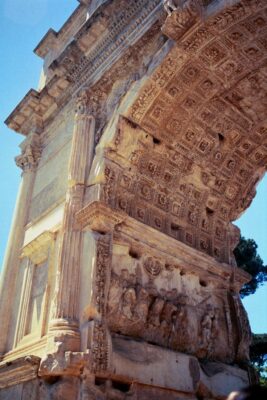
Conclusion
The Arch of Titus is more than just an architectural marvel; it is a profound narrative carved in stone, depicting the might, triumphs, and cultural significance of the Roman Empire. As you walk under its arches on the historic Via Sacra, you are transported back to a time of imperial grandeur and monumental achievements.

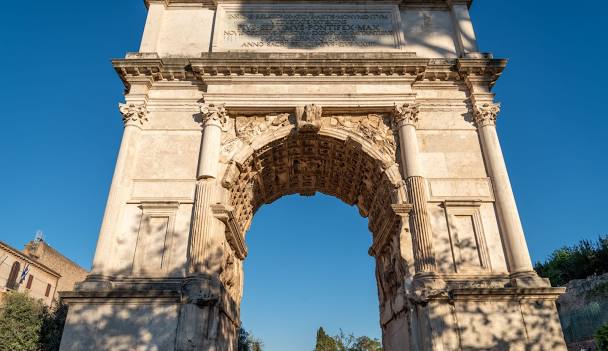
CÁC TIN KHÁC
Mary Walton: The Forgotten Inventor Who Helped Clean Up America’s Cities
Tomb of Queen Nefertari in the Valley of the Queens, Egypt
Discover the Hypostyle Hall of the Temple of Hathor at Dendera
Venus de Losange: Unveiling the Mystery of a 20,000-Year-Old Paleolithic Icon